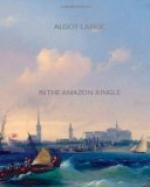I have mentioned the pirarucu several times as being the largest edible fish of the Amazon. When full grown, it attains a weight of two hundred and fifty pounds. In Lake Innocence we saw this remarkable fish feeding close to the shore in shallow water, surrounded by a school of young ones. The old one was about seven feet in length and the others but recently hatched, from nine to ten inches. The Indian who pointed them out to me stood up in the bow of the canoe and, fitting one of his five-foot arrows to the bow-string, sent it through the air and into the head of the big fellow.
The bow which he used was of his own manufacture. It was about seven and a half feet long, very tough and straight, and made of Caripari wood. The shafts of the arrows were made of long straight reeds, the stalks of a certain species of wild cane. The detachable part of the arrow is a short but extremely hard piece of wood upon which is fitted an iron head with two barbs. When the point pierces the flesh this hard piece comes off, but remains attached to the shaft by a short stout cord. This allows the shaft free play so that it will not break during the struggles of the victim. Then there is a line attached to the head itself so that the hunter can handle the struggling animal or fish by means of it and of the shaft of the arrow. The whole contrivance is a marvel of ingenuity in meeting the conditions the Amazon hunter is called on to face. When the arrow struck this particular pirarucu, at close range, he made straight for the shore, hauling the canoe and its contents after him at considerable speed. We got tangled among the low branches and fought the fish in considerable danger of being overturned—and I should not at all care to be capsized on Lake Innocence.
Finally, we got our prize ashore. I sent the Indian to headquarters, telling him to go, as fast as he could and bring assistance so that we could get the fish home. I myself mounted guard over the carcass to see that neither the turkey buzzards nor the carnivorous mammals should destroy it. If we had left it alone for even a short time, we would have found, on our return, little to remind us of its existence. The Indian returned shortly with two men. They stuck a pole through the great gills of the pirarucu and in this fashion carried it to the settlement.
These waters contain great quantities of another and smaller fish known as the piranha, scientifically termed Serraselmus piraya. This is quite as much dreaded by the natives as the alligator, or even as the shark along the coast. Its ferocity seems to know no bounds. It will attack other fish and bite large pieces out of their fins and tails. Although it is not much larger than the herring it can make fatal attacks on man when in large numbers.




